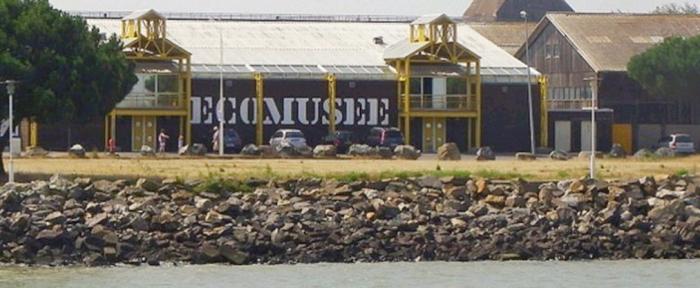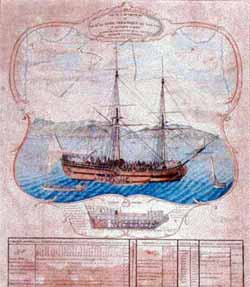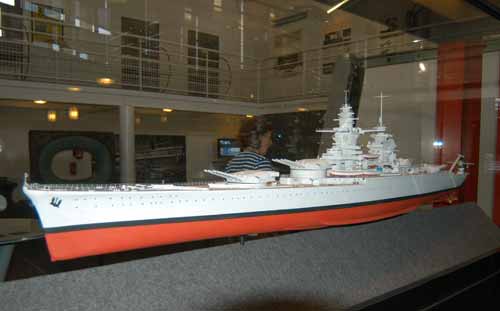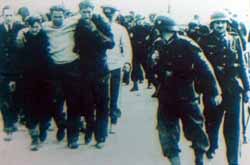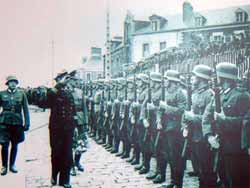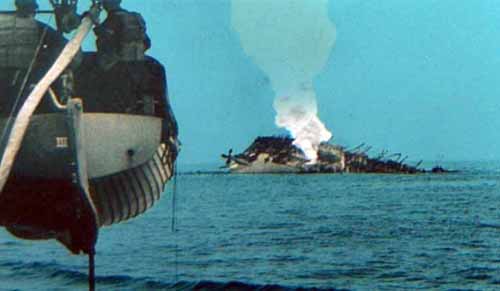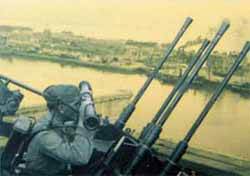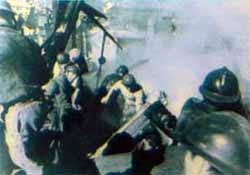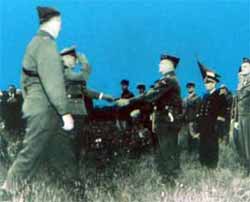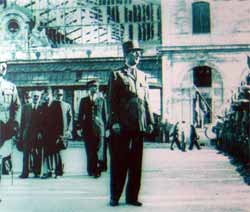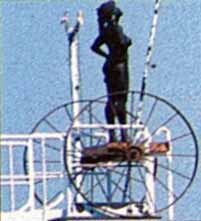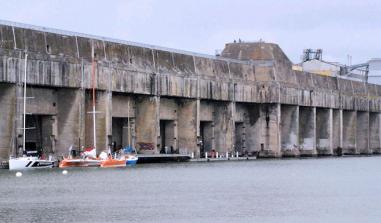Key specifications of the first version of the battleship (unfinished) in 1936:
Length: 248 m
Width: 33.08 m
Draught: 9.17 m
Displacement: 38,450 tonnes
Average speed: 32 knots
Power of propulsion machinery: 150,000 horse power
Number of rows of propeller shafts: 4
Armament:
8 380-mm cannons in two quadruplet turrets
15 152-mm cannons in five triple turrets
12 100-mm cannons in six dual turrets
12 37-mm cannons in six dual gun carriages
24 13.2-mm machine guns in six quadruple gun carriages
3 Loire-Nieuport hydroplanes and two catapults
Built by: Ateliers et Chantier de la Loire and Chantier de Penhoët, Saint-Nazaire
Shipowner: Marine Nationale
World War II (1940-1945)
Port occupation
During World War II, the port of Saint-Nazaire became an important strategic location. On 12 June 1940, the front was penetrated by the Wehrmacht troops and 40,000 British, Polish and Czech soldiers retreated to the port of Saint-Nazaire to try and sail to Britain. On 17 June, 3,000 refugees, soldiers and civilians were killed aboard the Lancastria liner which was leaving Saint-Nazaire and the Loire estuary. On 19 June, the battleship Jean Bart, under construction in Saint-Nazaire, floated out of the estuary to escape the German troops who finally broke through into the town on 21 June. In January 1941, the occupying forces started to build a submarine base as well as a series of bunkers along the coastline and at the mouth to the estuary and the port This fortified port was attacked by a surprise British commando raid on 27 March 1942, codenamed Operation Chariot. The British commando troops managed to neutralise the port equipment including the Joubert Lock situated between the two basins of the port thanks to explosions launched by the destroyer HMS Campbeltown.
HMS Campbeltown
Length: 101 m
Width: 9.90 m
Draught: 3.30 m
Max speed: 35 knots
HMS Campbeltown was an old American destroyer, before named the Buchanan, and put into service in 1920, until it was sold by the US to England in September 1940, with 49 other vessels, in exchange for the use of the British bases in Newfoundland and the West Indies. Once selected for Operation Chariot, HMS Campbeltown was sent to Portsmouth shipyard to be modified. Not only were five tonnes of explosives submerged in cement at the ships’s bow, it had to be made unrecognisable due to its slender form and four funnels. The rear funnels were taken off and the ones at the front were cut into whistle shapes, giving it the appearance of a German torpedo boat, such as the Möwe-Class. Lastly, it was painted in the usual colours of ships moving about the English Channel, so as to pass unnoticed as much as possible. Within three weeks, the ram-ship to be used in Operation Chariot was ready.
Town and port bombardments
The German submarine base of Saint-Nazaire represented a strategic target for the allied bombers. In actual fact, the town and its inhabitants were the main victims of the 50 bombings, causing 479 deaths, several hundred wounded and the near-total destruction of the town itself (85%). From the start of the Occupation, Saint-Nazaire was bombarded by the British airforce. It was from 1943 that the American “flying fortresses” came as reinforcements, firing out hundreds of explosive bombs and incendiaries. Faced with the impossible task of neutralising the submarine base, the Allied forces decided in 1943 to make the town uninhabitable and the port difficult to operate, launching bombings from high altitudes. The incendiary bombing of 28 February 1943 alone destroyed nearly half the town. Others followed, such as the bombardment of 29 May 1943 that saw a single raid by 170 bombers on Saint-Nazaire. After 1 March 1943, a total evacuation plan for the town’s inhabitants was organised. From then on, the population of Saint-Nazaire were forced to feel to neighbouring Brière and various other towns and villages in the Guérande Peninsula.
Liberation of the port
From June 1944, all of the French territory was liberated, except for pockets of German resistance around the submarine bases. From September 1944 to May 1945, the region of Saint-Nazaire was surrounded by American Allied troops and French resistance units across a 30-kilometre radius north and south of the Loire estuary. The centre of this fortress around Saint-Nazaire was the submarine base. On 10 May 1945, the German General Junck accepted to surrender the pocket of resistance in Saint-Nazaire and his 28,000 soldiers. On 11 May, the Allied troops entered the destroyed town, then the submarine base and seized a U-Boat, a type IX U-510 submarine, an oil ship, a hospital ship, two minesweepers, a dozen draggers, a dozen tugboats and 15 patrol boats. The U-510 was later incorporated into the French national navy and named the “Commandant Bouan". The Allied command set up its HQ onboard the German hospital ship, the München. On 23 July, General de Gaulle, head of the interim government, visited the town and the shipyards, all in ruins. He wrote the following simple inscription in the town’s visitor’s book: “Saint-Nazaire is an example and a symbol of hope”.
Call to the population
The German authorities confirmed that “French civilians participated yesterday evening in committing acts of war against the Occupying army. We cannot believe that this happened. We can only make our fellow citizens aware of the notice that has just been given to us: The entire population will be held responsible for any future attack. If the guilty parties are not found immediately, one-tenth of the inhabitants of the district where the attack is made will be shot without trial and without prejudice to more general measures that may affect the entire population. Thus any strike on the German army is a strike against the French. We are again calling on the population to urge the people to retain its calm and dignity. Saint-Nazaire, 31 March 1942, P. TOSCER, Mayor. GEORGELIN, GARREC, GAUFFRIAU, GRIMAUD, deputies.
Triangular commerce
The Loire estuary has always been used as a through route for merchant ships. A number of slave ships passed through this estuary in both directions between the 16th century right up until the 19th century. The slave ships were fitted out by Nantes-based ship owners with crews recruited from as far afield as the Guérande Peninsula. They left with manufactured goods and cheap objects used as currency to load up with slaves captured on the west coast of Africa (Senegal and the Gulf of Guinea). Slaves transported to the West Indies were exchanged for exotic goods (wood, sugar, coffee, etc.) that made their way back to Nantes. Thus Nantes, France’s main slave port, transported 450,000 Africans to Central America, 40% of all maritime traffic.
The abolition of slavery
With the French Revolution, the constituent assembly voted in on 26 August 1789 the Declaration of the Rights of Man and of the Citizen, the very philosophical and legal foundation of the French Republic. The main innovation of this text is summed up in its first article: “Men are born and remain free and equal in rights". In law only as there were limitations, such as the slaves not initially recognised as true citizens in the French colonies (West Indies). While the slaves were freed in these colonies in 1794, the triangular commerce continued until 1848 when the Second French Republic introduced its permanent abolition.
The Mayo sculpture
From 1863, a ferry provided a regular service across the estuary between Saint-Nazaire and the south bank in Mindin. The number of connections between the two banks grew with the introduction of ferries to transport passengers, animals and vehicles. From 1959, the links were made using two-way ferries that allowed the transport of motor vehicles, until the Saint-Nazaire bridge was opened in 1975. As part of the bicentennial commemoration of the French Revolution in 1989, Jean-Claude Mayo, an artist and sculptor from Réunion, made a piece from dolphins taken from the old gangway used for the Mindin ferry. His sculpture is made of pieces of wood that call to mind the ribs of a slave ship. Three bronze figures represent the different stages in the abolition of slavery.
Ecomuseum
Avenue de Saint-Hubert 44600 Saint-Nazaire
Tel: +33 (0)2 51 10 03 03
Fax: 02 51 10 12 03
E-mail: ecomusee@mairie-saintnazaire.fr
Source: MINDEF/SGA/DMPA
